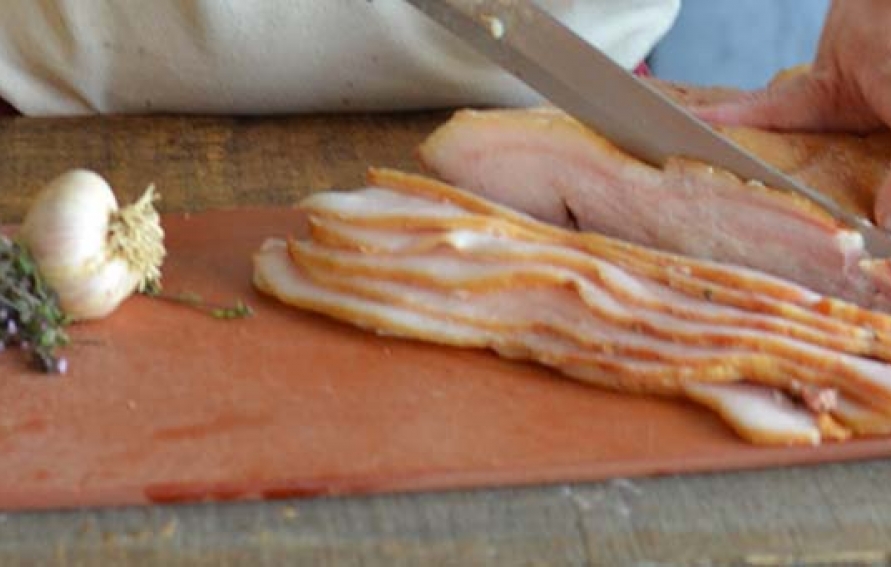Ingredients
- 2.5 kg pork belly, deboned
- 252 grams Kosher salt
- 252 grams brown sugar
- 1/4 cup summer savory
- 4 cloves garlic, mashed
Preparation
Maintaining the proper ratios of pork by weight to nitrities, sugar and salt is important to prohibit bacterial growth. Add 20 grams of Ready Cure for each kilogram of meat being cured.
From the Canadian Meat Council's (www.cmc-cvc.com) website:
"The preservation or curing of meat, poultry, fish, seafood and vegetables by salting predates written history. Nitrite provides both food safety and food quality benefits.
Nitrite is an essential curing ingredient that fixes the characteristic colour associated with cured meats, creates a unique flavour profile, controls the oxidation of lipids, and, most importantly, serves as an effective antimicrobial, particularly against Clostridium botulinium. Botulism is rare today because processing methods and preservatives such as sodium nitrite protect consumers.
Of the 100 to 200 mg/kg of nitrate and nitrite added to meats during the manufacturing process, the lion’s share is required for the control of C. botulinum. As nitrite levels increase, so does the inhibition of C. botulinum growth and toxin production. A small portion (25 mg/kg, or less) acts as a catalyst for colour development."
You'll also need:
Wood chips - apple is the favourite
Meat thermometer
Barbecue or smoker
Day 1 (10 minutes)
On a cutting board, chop the garlic cloves, then mash with a pinch of Kosher salt until it forms a smooth paste. In a medium mixing bowl, mix the garlic, spices, nitrites and sugar together to form the
cure. Rinse the belly with water and pat dry. With a small, sharp knife make small slits on both sides of the belly — this will allow the cure to fully penetrate.
Place the belly onto a baking sheet, allowing it to lay flat. Rub half of the ingredients into the top of the belly, flip it over and rub in the remaining cure. Cover and refrigerator for approximately 24 hours.
Day 2 (5 minutes)
The next day, take the belly out of the refrigerator and re-apply the cure to both sides. Cover and place back into the refrigerator for another 24 hours.
Day 3 (6-8 hours)
Remove the belly and wash with cool water to remove all of the cure. Pat dry with a clean towel and allow it to dry for about an hour (if possible, hanging it to dry is best). At this point, a pellicule or film should have developed, which looks wet, but is actually dry, enabling better smoke absorption.
While the cured belly is drying, prepare the barbecue or smoker:
Charcoal barbecue - A charcoal barbecue gives the best flavour. Just add the woodchips directly to the coals.
Gas or propane grill - Place an aluminum tray with wood chips on one half of the grill. Get the chips to smoulder by lighting, then extinguishing the flame.
Smoker - Follow the manufacturer's instructions.
Place the pork belly on the grill with a drip tray underneath the grill to catch the melting fat, then light the barbecue. This will help avoid losing any smoke.
Reach and maintain a steady temperature between 200 - 225F. Keep the lid closed, allowing the belly to smoke uninterrupted for about 90 minutes (keep an eye on it to avoid flare-ups from the melting fat).
After 90 minutes, check the belly with a meat thermometer in various locations, especially the thickest parts. The bacon is done when it reaches and internal temperature of 151F (a little over is fine, but do not undercook).
Remove the bacon and cool. It can be eaten right away, or sliced and cooked. Wrap and store in the refrigerator for 2 weeks or bacon can be frozen for two months — if you can wait that long.




